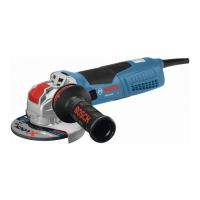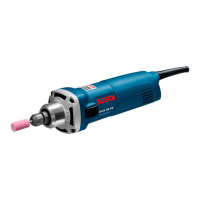8 | English
1 609 92A 363 | (24.11.16) Bosch Power Tools
Integrated Dust Extraction with Dust Box
(seefiguresG1–G4)
Attach the dust box 4 onto the extraction outlet 12 until it
latches.
To empty the dust box 4, pull off the dust box downward.
Before opening the dust box 4, it is recommended to loosen
the dust from the filter element by gently striking it against a
firm support (as shown in the figure).
Grasp the dust box 4 by the recessed grip, fold the filter
element 13 upward and empty the dust box. Clean the thin
plates of the filter element 13 with a soft brush.
External Dust Extraction (see figure H)
Mount a vacuum hose 14 onto the extraction outlet 12. Con-
nect the vacuum hose 14 with a vacuum cleaner. An overview
for the connection of various vacuum cleaners can be found at
the end of these instructions.
The vacuum cleaner must be suitable for the material being
worked.
When vacuuming dry dust that is especially detrimental to
health or carcinogenic, use a special vacuum cleaner.
Replacing the Sanding Sheet
When attaching a new sanding sheet, remove any dust or
debris from the sanding plate 6 (e. g. with a brush).
To ensure optimum dust extraction, pay attention that the
punched holes in the sanding sheet match with the holes in
the sanding plate.
Sanding Sheets with Velcro Backing (see figure A)
The sanding plate 6 is fitted with Velcro backing for quick and
easy fastening of sanding sheets with Velcro adhesion.
Before attaching the sanding sheet 7, free the Velcro backing
of the sanding plate 6 from any debris by tapping against it in
order to enable optimum adhesion.
Position the sanding sheet 7 flush alongside one edge of the
sanding plate 6, then lay the sanding sheet onto the sanding
plate and press firmly.
To remove the sanding sheet 7, grasp it at one of the tips and
pull it off from the sanding plate 6.
Sanding Sheets without Velcro Backing (see figures B– D)
Press the release button 8 and keep it depressed.
Guide the sanding sheet 7 to the stop under the opened
front clamping bracket 9 and let go of the release button
8 again. Pay attention that the sanding sheet is clamped
centrally.
Press the sanding sheet clamp 5 inward and pivot it to
the stop.
Fold the sanding sheet 7 firmly around the sanding plate.
Guide the other end of the sanding sheet 7 between the
rear clamping bracket and the red roller on the clamping
bracket 5.
Hold the sanding sheet tensely and press the clamping
bracket 5 toward the sanding plate to lock the sanding
sheet.
Sanding sheets without holes, e. g. from rolls or by the meter,
can be punctured with the perforating tool 10 for use with
dust extraction. For this, press the machine with the mounted
sanding sheet onto the perforating tool (see figure E).
To remove the sanding sheet 7, loosen the clamping
bracket 5 and pull out the sanding sheet from the rear holding
fixture. Press the release button 8 and completely remove the
sanding sheet.
Selecting the Sanding Sheet
Depending on the material to be worked and the required rate
of material removal, different sanding sheets are available:
Replacing the Sanding Plate (see figure F)
The sanding plate 6 can be replaced, if required.
Unscrew the 4 screws 11 completely and remove the sanding
plate 6. Attach the new sanding plate 6 and tighten the screws
again.
Operation
Starting Operation
Observe correct mains voltage! The voltage of the
power source must agree with the voltage specified on
the nameplate of the machine. Power tools marked
with 230 V can also be operated with 220 V.
Switching On and Off
To start the machine, press the On/Off switch 2 and keep it
pressed.
To lock the pressed On/Off switch 2, press the lock-on button
3.
To switch off the machine, release the On/Off switch 2 or
when it is locked with the lock-on button 3, briefly press the
On/Off switch 2 and then release it.
Grain size
For the working of all wooden
materials
40—240
For coarse-sanding, e. g. of
rough, unplaned beams and
boards coarse 40, 60
For face sanding and planing
small irregularities medium 80, 100, 120
For finish and fine sanding of
hard woods fine 180, 240
For the working of
paint/enamel coats or
primers and fillers
40—320
For sanding off paint coarse 40, 60
For sanding primer medium 80, 100, 120
For final sanding of primers
before coating fine 180, 240, 320
OBJ_BUCH-243-003.book Page 8 Thursday, November 24, 2016 2:16 PM

